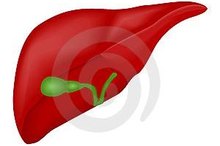Fatty Liver and Gallstones
**Fatty liver disease, or steatosis, is the most common cause of elevated liver enzymes in the United States, according to the American Family Physician website 1. Steatosis results from the accumulation of lipids, specifically triglycerides, in the cells of your liver, which triggers an inflammatory response that prompts the leakage of liver enzymes into your bloodstream. Fatty liver disease occurs in a number of situations, such as alcohol abuse, obesity and type 2 diabetes. If you have fatty liver disease, your risk for developing gallstones increases.
Gallstones
Your gallbladder is a hollow, pear-shaped organ that rests beneath your liver. It stores bile produced by your liver and excretes it into your small intestine to facilitate the digestion of fats. Gallstones form when your gallbladder doesn't empty normally or when the normal composition of chemicals in your bile is disrupted, thereby allowing precipitation of stone-forming particles. According to “The Merck Manual of Diagnosis and Therapy,” 85 percent of gallstones are formed from solidified cholesterol.
- Your gallbladder is a hollow, pear-shaped organ that rests beneath your liver.
- Gallstones form when your gallbladder doesn't empty normally or when the normal composition of chemicals in your bile is disrupted, thereby allowing precipitation of stone-forming particles.
Correlation
Bloated With an Upset Stomach After Every Meal
Learn More
Steatosis affects up to two-thirds of obese individuals, according to the American Family Physician site, and it is frequently diagnosed in people with type 2 diabetes and metabolic syndrome, a condition characterized by abdominal obesity, high blood pressure, insulin resistance and high triglycerides. Risk factors for gallstones mirror those for fatty liver disease. A study in the December 2010 issue of “The Turkish Journal of Gastroenterology” showed that 55 percent of 95 patients undergoing surgery for gallstones also had fatty liver disease 3.
Common Mechanisms
According to scientists at The Netherlands’ Leiden University Medical Center, obesity and high serum triglyceride levels interfere with gallbladder activity and contribute to abnormal bile composition, thereby increasing your risk for gallstones. Likewise, insulin resistance impairs gallbladder function, alters cholesterol metabolism and heightens your chances for gallstones. These are the same physiologic abnormalities that increase your risk for developing fatty liver disease.
Considerations
Does Losing Weight Help Lower Elevated Liver Enzymes?
Learn More
The association between fatty liver disease and gallstones is based upon risk factors and metabolic derangements that are common to both conditions. Modifiable risk factors for gallstones and fatty liver include obesity and metabolic syndrome, both of which can be addressed with weight loss, exercise and dietary modifications such as a low-fat, low-sugar diet. You also can at least partly address other conditions that increase your risk for fatty liver and gallstones – type 2 diabetes and high triglyceride levels – through these same lifestyle changes. If you suffer from type 2 diabetes, metabolic syndrome or obesity, ask your doctor how you can protect yourself from gallstones and fatty liver disease.
- The association between fatty liver disease and gallstones is based upon risk factors and metabolic derangements that are common to both conditions.
- You also can at least partly address other conditions that increase your risk for fatty liver and gallstones – type 2 diabetes and high triglyceride levels – through these same lifestyle changes.
Related Articles
References
- “American Family Physician”; Nonalcoholic Fatty Liver Disease; M. Bayard, et al.; June 2006
- “The Merck Manual of Diagnosis and Therapy, 18th Edition: Cholelithiasis”; Mark H. Beers, M.D., Editor-in-Chief; 2006
- “The Turkish Journal of Gastroenterology”; Gallstones Associated with Nonalcoholic Steatohepatitis (NASH) and Metabolic Syndrome; O. Yener, et al.; December 2010
- “Clinica Chimica Acta”; Triglycerides and Gallstone Formation; A.H. Smelt; November 2010
- National Institute of Diabetes and Digestive and Kidney Diseases. Symptoms & Causes of Gallstones. Updated November 2017.
- Stinton LM, Shaffer EA. Epidemiology of gallbladder disease: cholelithiasis and cancer. Gut Liver. 2012;6(2):172-87. doi:10.5009/gnl.2012.6.2.172
- Johns Hopkins Medicine. Gallstones.
- National Institute of Diabetes and Digestive and Kidney Diseases. Dieting & Gallstones. Updated November 2017.
- Johansson K, Sundström J, Marcus C, Hemmingsson E, Neovius M. Risk of symptomatic gallstones and cholecystectomy after a very-low-calorie diet or low-calorie diet in a commercial weight loss program: 1-year matched cohort study. Int J Obes (Lond). 2014;38(2):279-84. doi:10.1038/ijo.2013.83
- Johns Hopkins Medicine. Gallstones.
- Mayo Clinic Staff. Gallstones. Mayo Clinic. Updated November 17, 2017.
- National Institute of Diabetes and Digestive and Kidney Diseases. Dieting and Gallstones. National Institutes of Health. U.S. Department of Health and Human Services. Updated November 2017.
- National Institute of Diabetes and Digestive and Kidney Diseases. Symptoms and Causes of Gallstones. National Institutes of Health. U.S. Department of Health and Human Services. Updated November 2017.
- Portincasa P, Di Ciaula A, Grattagliano I. Preventing a Mass Disease: The Case of Gallstones Disease: Role and Competence for Family Physicians. Korean Journal of Family Medicine. 2016;37(4):205-213. doi:10.4082/kjfm.2016.37.4.205.
Writer Bio
Stephen Christensen started writing health-related articles in 1976 and his work has appeared in diverse publications including professional journals, “Birds and Blooms” magazine, poetry anthologies and children's books. He received his medical degree from the University of Utah School of Medicine and completed a three-year residency in family medicine at McKay-Dee Hospital Center in Ogden, Utah.









